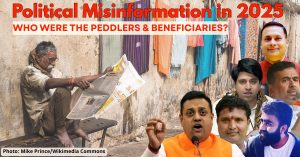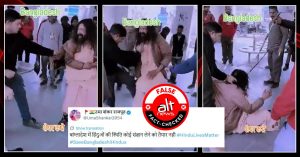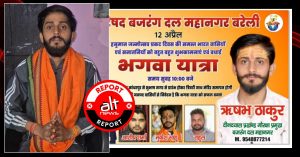Trigger Warning: Graphic Imagery
What the world witnessed in Nepal last week was not just a protest against a social media ban, but a spontaneous outpouring of pent up anger at an allegedly failed system. An analysis of the idioms, motifs and visual representations of the GenZ uprising shows that calling it a protest against social media ban — as a section of the media did — was to trivialize it to an extent as to misconstrue it wholly.
At best, the September 4 ban on certain social media platforms was a spark that turned an already smoldering fire into a blaze. A blaze fuelled by the rage of the country’s youth against systemic corruption, nepotism, economic failures, a privilege culture and so on.
The turmoil in Nepal hit headlines worldwide and also in India on September 8, when 19 student protesters lost their lives in clashes with security forces, and the streets of Kathmandu resembled a battlefield. Despite the violence and loss of lives, the protests continued on to the following day, ultimately leading to the toppling of Prime Minister K P Sharma Oli’s government. By this time, however, what began as a youth uprising against corruption, nepotism, unemployment and issues alike, had lost its way into the quagmire of anarchy. The Supreme Court, the Singha Durbar palace, which is the seat of the Nepal government, and the Parliament had been set fire to. So were the houses of the Prime Minister and several of his cabinet colleagues.
Kathmandu had fallen.

Anger at Corruption, Nepotism, Elitism
In July 2024, former UN Resident Coordinator Bishow Parajuli wrote an analytical piece in The Kathmandu Post titled ‘Corruption: Nepal’s cry for help’, highlighting public frustration with political parties, government officials, business leaders, and civil society actors in Nepal. Parajuli shows that anti-corruption institutions in Nepal are seen as ineffective, with leadership often compromised by political patronage, and efforts at reform stymied by threats of political destabilization. This entrenched corruption negatively affects development, jobs, health, education, and public infrastructure; major scandals routinely go unpunished, while both local and federal government remain plagued by graft. According to the analysis:
-
An estimated 75,000-80,000 people leave Nepal every month seeking employment abroad.
-
About 100,000 students went abroad for studies in 2023-24, with most unlikely to return.
-
Out of 28,000 cases filed by the Commission for Investigation of Abuse of Authority (CIAA) in a year, about half involved local government units.
For years, the youth of Nepal have been dissatisfied with the country’s failure to meet their aspirations. Even though the economy has reportedly recovered from the slump caused due to COVID-19, with the real GDP of the country growing by 4.9% in the first half of 2024-25 from 4.3% in the same half of 2023-24, the growth in GDP has not translated into an increase in employment or job creation. Quality jobs have been scarce in Nepal, with people aged under 35 being the major stakeholders of the adversity. In 2024, youth unemployment rate stood at 20.8% against a global average of around 12.5%. As a result, hundreds of thousands migrate abroad each year to the Gulf and Malaysia. Nepal’s economy is heavily dependent on remittances or money sent from abroad, accounting for more than a third of the country’s GDP. However, this too has been inefficient in the creation of quality jobs in the country.

The anger that was brewing for a long time brimmed over this September. Nepali social media platforms such as TikTok and X saw a surge in the hashtag #NepoBabies from the beginning of this month, reflecting a collective outrage against entrenched political corruption, nepotism, and privilege enjoyed by the children of influential politicians.
This broader movement against political nepotism and corruption was the primary driver behind the protests, and the social media ban acted as a catalyst when on September 4, the Nepal government announced that it would block several social media platforms, including Facebook, YouTube and X, for failure to register with authorities. Acting on a Supreme Court order, the government had given the platforms time until September 3 to register with the ministry of communications and information technology and name a local grievance handling officer and a compliance officer. While Meta, X, YouTube and a few others failed to do so, TikTok, Viber, WeTalk, etc. had registered, and hence these did not come under the ban.
The privilege culture, or the notion that if you are high and mighty, you could get away with anything was captured by an incident reported by The Times of India. An 11-year-old girl was hit by the car of Koshi province minister Ram Bahadur Magar on September 6 and it was dismissed by now-ousted Prime Minister Oli as a ‘normal accident’. As photos of the injured child began circulating via mobile phones, the incident and Oli’s remarks triggered massive discontent among the youth. A 20-year-old student told the paper, the footage of the child left on the roadside sparked a change in the tone of conversations overnight. “They didn’t just brush off a child’s pain. They showed us that we don’t matter. We were already angry about corruption, nepotism and no jobs. This was the spark,” she said.
A widely shared photo from September 8 that became synonymous with the violence in Nepal shows a handwritten poster lying next to a pool of blood. It says, “No more corruption. It’s our country and we want change. #CorruptionEnd”

A college student summed this up when she told BBC, “We want to see an end to corruption in Nepal,” adding, “Leaders promise one thing during elections but never deliver. They are the cause of so many problems.” She also stated that the social media ban had disrupted her education, limiting access to online classes and study resources.
From a TikTok Revolution to a Mass Uprising
It is an irony of sorts that social media played a pivotal role in both shaping and mobilizing the movement in the initial phase. To begin with, the dissent against the government took the form of memes, shorts and impactful videos, often under the #NepoBabies banner, on social media platforms. Many of these showed the lives of ordinary Nepali citizens contrasting starkly with the opulent lifestyles of children of politicians and bureaucrats and elite families — often in foreign countries, dining at high-end restaurants, riding in luxury cars, and displaying expensive accessories and designer labels.
The video embedded below, for instance, shows the son of former Chief Justice of Nepal Gopal Parajuli’s son Sayuj Parajuli, posing next to cars and in fancy restaurants. “Openly flexing luxury cars and watches on social media. Arent we tired of them by now?” reads the caption that was posted alongside hashtags like #corruption. The video garnered close to 2 million views on TikTok.
Several others were ‘exposed’ in a similar fashion by user @neponepalitok. This included Communist Party of Nepal leader Birodh Khatiwada’s daughter Shrinkhala, former Prime Minister Sher Bahadur Deuba’s son Jaiveer and Late Nepalese politician Deepak Bohara’s daughter Supriya Bohara.
It is worth noting that as the protests turned into largescale mob violence in Kathmandu on September 9-10, the Deuba family — the former PM and his wife who was the foreign minister in the now-ousted government– was brutally attacked.
An Indian Express report shows how ministers in Nepal are often granted immunity in investigations. Several government officials face corruption charges. Former PM Oli faces a contempt case for allegedly violating a Supreme Court order against converting a tea estate into commercial plots. Three other former PMs, Madhav Nepal, Baburam Bhattarai, and Khil Raj Regmi, are accused in scams wherein government land was handed over to private entities. Complaints are pending against three-time PM Prachanda for allegedly making billions by diverting money meant for Maoist guerrillas when they were kept in UN-monitored cantonments during the peace process that began in late 2006. Deuba is accused of taking illegal commissions in the purchase of aircraft, and his wife Arzu Rana has often faced questions in Parliament about her alleged role in fraudulently turning Nepali citizens into Bhutanese nationals on paper, and sending them to the United States as “refugees”.
On September 6, just two days before the protests reached the climax and took a violent turn, the Kathmandu Post reported that the rapidly growing online dissent, particularly on TikTok and Reddit, was “likely to spill onto the streets.” The report noted that users were already calling for demonstrations in Baneshwar and other areas, with many declaring that the GenZ was “waking up” and that it was time to take digital campaigns into the real world through physical protests. Even with restrictions already being imposed on social media, organisers affirmed their intention to proceed with street demonstrations starting Monday, September 8.
On the 8th, the Kathmandu Post confirmed that the non-profit ‘Hami Nepal’ had organised a major rally at Maitighar in Kathmandu and had invited students to join, even encouraging them to attend in their uniforms. ‘Hami Nepal’ leader Sudan Gurung stated the protest was a direct response to government actions and corruption.
Numerous TikTok videos went viral inviting the youth to the September 8 protests, with the majority emphasizing that it was a movement against corruption. In fact, the protest banner of ‘Hami Nepal’ explicitly reads “Youths Against Corruption.” The government’s ban on social media platforms was mentioned only as a secondary issue, an ancillary point, almost a footnote, in the broader anti-corruption movement.
“PROTEST! Nepal Politician’s kids living luxury life on Tax money? Youth’s Gear up for 8 sept“, “STOP CORRUPTION We Are the Youth, We Are the Power!“, and “Raise your voice, break the chains of corruption. Together, let’s build a just and accountable Nepal” were some of the clarion calls made for the protest on September 8.
How Media Covered the Protests
What set off the unrest in Nepal was something much bigger and deeper than the social media ban — this was a point several of media reports missed altogether. While the allegations of largescale corruption had initially been mentioned by Indian media outlets in passing, several news anchors mentioned how the youth were addicted to their phones, and some even cited academic research to prove that the Nepali youth’s screentime was high. Needless to say, this was beside the point, and in a way, trivialized the protests.
On state-run DD News, Sudhir Chaudhury’s interpretation of the protests was this: “Social Media is the youth’s lifeline. You can take away their atta (wheat flour) but not their data. If you have to compare Atta and data, then you can snatch their atta. The real food is not atta but data. The Nepal government made a mistake by banning social media… The youth used to vent their anger on social media. The matter would get done on social media itself. But that one source of venting anger was banned by the Nepali government. Now the anger on social media is being taken out on the streets… The youth want social media at every cost…”
On Aaj Tak, Anjana Om Kashyap went on to present statistics about the average Nepali undergraduate student’s screentime. “According to ResearchGate, their average screentime is 7 hours 12 minutes every day. The majority of the youth use phones more than they sleep.” She also said the average Nepali’s screentime is 7 hours, which is more than an average Indian’s screentime (5 hours).
Aman Chopra on ‘Desh Nahi Jhukne Denge’ on News18 India harped on the same string. Tickers like “”सोशल मीडिया बैन से सुलगे युवा या कहानी कुछ और?” (Translation: “Did the youth flare up due to the social media ban, or is there another story?) were aired on-screen. He also presented data on the number of social media users in Nepal.
Conspiracy theories also did the rounds — from suggestions that there were foreign entities at play to insinuating that the demonstrations were pre-planned operations or deep-state conspiracies.
In their early reportage of the protests in Nepal, the BBC also focused mainly on the government’s decision to ban social media.
The protests were depicted in a similar way by international media outlets like The Guardian, NBC News, UN News and AP, which dubbed the demonstration as one primarily against a social media ban. This, despite a protester clearly telling NBC News that they were protesting against corruption.
The Tribune tweaked the headline of their main report on the violence of September 8 from “19 killed in Nepal’s ‘GenZ’ protests against social media ban; HM quits” to “Social media ban sparks bloodshed in Nepal; 19 protesters killed, govt yields.” The original headline is still visible in the link text and in the thumbnail of the X post by the outlet.
Featured Image by Atreyo Roy
Independent journalism that speaks truth to power and is free of corporate and political control is possible only when people start contributing towards the same. Please consider donating towards this endeavour to fight fake news and misinformation.




